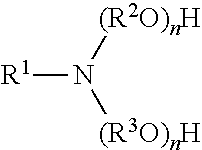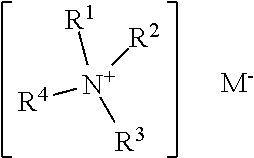Synergistic fuel additives and fuels containing the additives
a fuel additive and additive technology, applied in the field of fuel additives, can solve the problems of increasing the deposits of intake valves in gasoline engines, the performance of additives that are not effective in improving lubricity and reducing wear in fuel delivery systems, and the performance of additives that are not effective in improving lubricity and reducing wear, etc., to achieve the effect of reducing friction and wear, and improving fuel economy
- Summary
- Abstract
- Description
- Claims
- Application Information
AI Technical Summary
Benefits of technology
Problems solved by technology
Method used
Image
Examples
examples
[0033]The following examples are illustrative of exemplary embodiments of the disclosure. In these examples as well as elsewhere in this application, all parts and percentages are by weight unless otherwise indicated. It is intended that these examples are being presented for the purpose of illustration only and are not intended to limit the scope of the invention disclosed herein.
[0034]In the following example, a friction test was conducted on an E-10 gasoline fuel. All of the runs contained Eli) gasoline and the amount of additive listed in the table. The friction tests were conducted using a high frequency reciprocating rig (HFRR) using method ASTM D 6079 that was modified to allow testing the gasoline at a temperature of 25° C.
[0035]
TABLE 1ExTreat RateHFRRNo.Additive(ppmw)MWSD (μm)1E-10 base fuel with no additive08042E-10 base fuel plus Mannich detergent and alkyl polyether2808053Run 2 plus glycerol mono cocoate407614Run 2 plus cocoamine diethoxylate407255Run 2 plus cocoamine di...
PUM
| Property | Measurement | Unit |
|---|---|---|
| temperature | aaaaa | aaaaa |
| temperatures | aaaaa | aaaaa |
| temperature | aaaaa | aaaaa |
Abstract
Description
Claims
Application Information
 Login to View More
Login to View More - R&D
- Intellectual Property
- Life Sciences
- Materials
- Tech Scout
- Unparalleled Data Quality
- Higher Quality Content
- 60% Fewer Hallucinations
Browse by: Latest US Patents, China's latest patents, Technical Efficacy Thesaurus, Application Domain, Technology Topic, Popular Technical Reports.
© 2025 PatSnap. All rights reserved.Legal|Privacy policy|Modern Slavery Act Transparency Statement|Sitemap|About US| Contact US: help@patsnap.com



